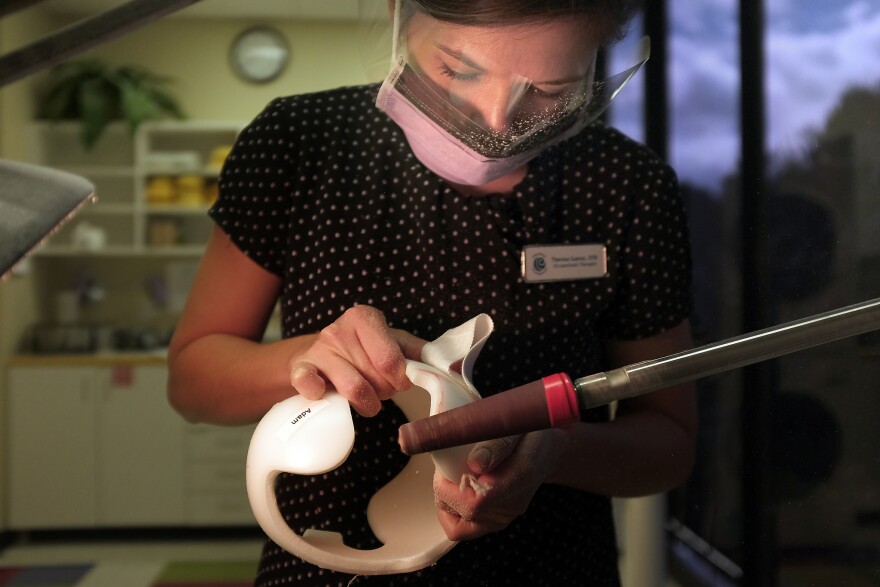As parents of newborns have been following pediatric recommendations of putting their babies to sleep on their backs to prevent Sudden Infant Death Syndrome, or SIDS, there has been a steep rise in babies with misshapen skulls. Now, doctors have increased prescribing orthotic headgear to correct the condition among infants.
As many as 47 percent of infants have found to have some degree of the condition called brachycephaly – when an infant's skull flattens after prolonged periods of laying on its back.
Carly Aly was not surprised that her four-and-a-half month-old triplets would need orthotic helmets: misshapen skulls are not uncommon for multiple births, who have less room to move around when babies are in utero.

“From my recollection, there was not a lot of movement for them past about 24-ish weeks,” she said. “Every time we went back to the doctor, they were in the exact same place. So, I had done a lot of reading that that can contribute to these issues.”
Last week, Aly and her nanny, Linda Gomez, took the triplets – Camille, Adam and Sofia – for their first fitting at Cranial Technologies, which specializes in the orthotic helmets. All three of them got helmets made of a lightweight, white, plastic shell lined with a soft foam, held snugly in place with a Velcro strap.
Parents looking to dress up the helmets with colorful decals – like for a football player, or a princess – will have to spend extra, about $100 a pop. Aly said the babies will do without that touch.
A few weeks earlier, they were measured with high-tech machines to build custom-made plastic helmets.

Dr. Thomas Luerssen, a pediatric neurosurgeon at Texas Children’s Hospital in Houston, said the misshapen baby skulls would probably get more normal as time gets by all on their own. But, Luerssen said, the helmets make that progress faster.
“The idea of the helmets is that they sort of immediately reposition the baby inside this shell and take the pressure off the flat part of the skull, and then it starts to regrow faster,” Luerssen said.
Pediatric medical professionals agree that more babies are getting cranial orthotic helmets today, largely due to the success of the Back to Sleep campaign, a nationally-funded program to reduce the number of infant deaths attributed to SIDS.
And, the rate of SIDS has dropped substantially – from 130 per 100,000 live births in 1990 to fewer than 40 deaths per 100,000 live births in 2014. But the trade-off has been that as many as 47 percent of babies today are being diagnosed with having misshapen heads, according to studies.
Before prescribing an orthotic helmet, pediatricians recommend simple repositioning. That includes moving the infant frequently, enticing her to look from one side to another and letting her spend time on her stomach with close supervision. But when that fails, a helmet may be called for.
“We have a protocol here,” Luerssen said. “There has to be a certain degree of severity, and they have to have a particular age to get the kind of response that we want. And there has to be understanding from the family about how the helmet’s supposed to be maintained and monitored. And once we have all that, if they elect to go for a helmet, because that’s what works for them, then that’s what they get.”
Representatives for Cranial Technologies, where the Aly triplets are getting their helmets, say different insurance companies vary in their criteria for whether they’ll cover the cost of orthotic helmets. For many families, insurance is the determining factor about whether or not to opt for a helmet. A helmet like the kind they have at Cranial Technologies may cost $3,000. And if the baby is required to wear it for a year, she may need a second helmet to accommodate the bigger head size.

The Aly triplets are lucky: because they were premature, they are technically only 13 weeks old. That means their skulls are even more malleable.
“Which is why they’re hoping that the treatment will respond a little quicker, hopefully, within that four to six weeks because their heads are a little softer,” she said.
At first, Aly and her nanny will be removing the helmet every 3-4 hours to check for redness. Once the babies are used to the helmets, they’ll wear them 23 hours a day. The only time the helmets will come off will be to have them cleaned with rubbing alcohol.
The big question is whether the orthotic helmets are medically necessary, as some wonder whether the problem of a misshapen head is cosmetic or functional.
“Cosmetic is definitely a part of it,” Aly said. “But that’s not why you chose to treat it. Could we probably live a relatively normal healthy, happy life? I don’t know, I don’t know. But, from what I’ve read, why chance it if you can get treatment?”
But pediatric neurosurgeon Luerssen said the orthotic helmets are being over-prescribed, and a 2014 study suggested the helmets do next to nothing to reshape an infant's head.
“It’s cosmetic. I mean it doesn’t really affect their brain function all,” he said. “It’s just simply a way of making sure that they look as normal as possible."
For the parents getting their infants fitted for helmets, normal might be all they’re looking for.




